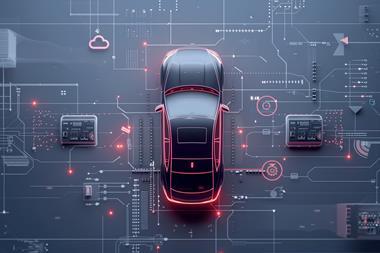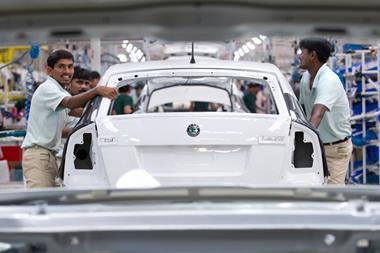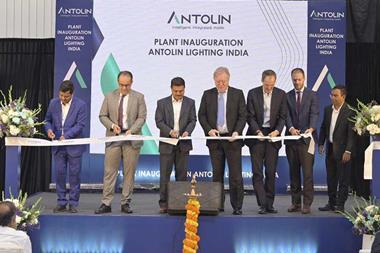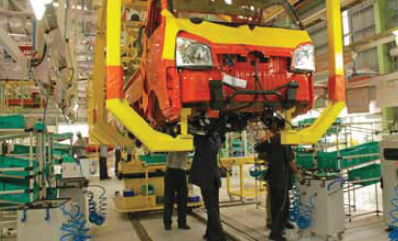 In March this year, Mahindra inaugurated its new auto manufacturing plant at Chakan, Maharashtra state, with ambitious plans for India’s most efficient and environmentally low-impact plant.
In March this year, Mahindra inaugurated its new auto manufacturing plant at Chakan, Maharashtra state, with ambitious plans for India’s most efficient and environmentally low-impact plant.
The Chakan project is spread across 700 acres, with a phased investment of approximately Rs.5000 crore ($1.1 billion) for the Chakan plant. The plant has an installed capacity of 3,000 vehicles per year and can be scaled up to meet global demand, as there is ample surrounding space. Mahindra Chakan manufactures the company’s range of products from the 0.75 tonne Maxximo to the 49 tonne Mahindra Navistar truck. The company’s new SUV and Pik- Up range and product line for the US market are currently - or will be - manufactured there.
Multi-model flexibility
Mahindra Chakan has been designed as a fully-integrated facility for multiple different platforms, including press, body, 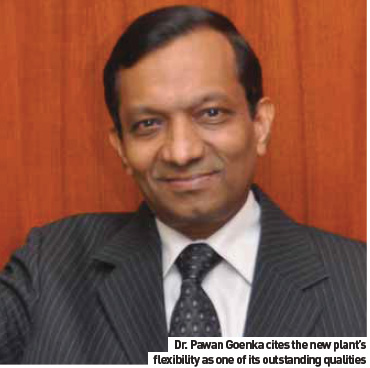 paint and general assembly. While it will manufacture the full range of the company’s medium and heavy commercial vehicles, it is also flexible enough to accommodate production of other models if required by future market demand. AMS asked Dr. Pawan Goenka, President, Automotive & Farm Sector, how the plant fits into Mahindra & Mahindra’s portfolio: “Growth over the last few years has been significant and at the same time our product portfolio has expanded to make us a full-range automotive player in India. Going forward, we believe in the potential of the Indian market, but we also have aggressive plans for exports. Key to the future will be products and capacity. We have a very aggressive product development plan and what was needed was a step jump in manufacturing capacity as our existing plants would very soon reach their optimum level of operation. Hence Chakan – a future-ready plant for M&M.The plant is future ready in terms of capacity and capability. Spread over 700 acres, the plant will be developed in phases. In Phase 1, we have a capacity of 300,000 vehicles per year. In terms of technology, with flexible and worldclass manufacturing systems, the Chakan plant is capable of manufacturing products of a very wide range – from a 0.75 tonne mini truck to a 49 tonne heavy truck, to world-class SUVs that include our new (W201) SUV model.”
paint and general assembly. While it will manufacture the full range of the company’s medium and heavy commercial vehicles, it is also flexible enough to accommodate production of other models if required by future market demand. AMS asked Dr. Pawan Goenka, President, Automotive & Farm Sector, how the plant fits into Mahindra & Mahindra’s portfolio: “Growth over the last few years has been significant and at the same time our product portfolio has expanded to make us a full-range automotive player in India. Going forward, we believe in the potential of the Indian market, but we also have aggressive plans for exports. Key to the future will be products and capacity. We have a very aggressive product development plan and what was needed was a step jump in manufacturing capacity as our existing plants would very soon reach their optimum level of operation. Hence Chakan – a future-ready plant for M&M.The plant is future ready in terms of capacity and capability. Spread over 700 acres, the plant will be developed in phases. In Phase 1, we have a capacity of 300,000 vehicles per year. In terms of technology, with flexible and worldclass manufacturing systems, the Chakan plant is capable of manufacturing products of a very wide range – from a 0.75 tonne mini truck to a 49 tonne heavy truck, to world-class SUVs that include our new (W201) SUV model.”
Dr. Goenka also covers Reva electric vehicles, now part of the Mahindra family: “Mahindra Reva vehicles are being made at the manufacturing unit in Bangalore. We have no immediate plans to produce Reva vehicles at the Chakan plant.”
Plant engineering and facilities

AMS went on to speak to L. P. Pereira, CEO at Mahindra, who summed up the facility as follows:
L. P. Pereira:Where technology turns into sustainable measures, where innovation is fine-tuned to smart efficiency, where frugal engineering is the hallmark, that’s the magic you will find put into practice at our plant in Chakan. We are a ‘visual’ automotive assembly plant which features the latest green, sustainablity initiatives. Further, it is a lean plant, which is well connected. It has also been designed to be a pleasant and friendly place to work.
AMS: Tell us about the Mahindra Manufacturing System (MMS) and what are the parameters (andon, etc.) that you use?
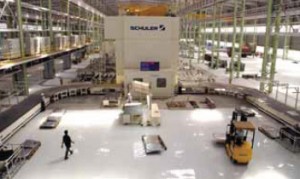 The Chakan plant features press equipment supplied by Schuler. This incorporates a cross bar feeder mechanism, the first installation of its kind in India, link-driven presses and an acoustic enclosure that ensures substantial sound deadening, in turn leading to a more worker-friendly environment. A synchronized off-cut conveying system delivers scrap directly to trucks.
The Chakan plant features press equipment supplied by Schuler. This incorporates a cross bar feeder mechanism, the first installation of its kind in India, link-driven presses and an acoustic enclosure that ensures substantial sound deadening, in turn leading to a more worker-friendly environment. A synchronized off-cut conveying system delivers scrap directly to trucks.Features:
• High speed, fully automatic, four-press line
• 3.22m line strokes per year
• Average production rate of 1 panel every 5 seconds
• Die-to-die panel transfer using cross bar feeder technology
• 2,400 tonne header press
• Three 1,000 tonne presses
• Die change in 3 minutes
• Design accommodates aluminium panel production
• Numerically-controlled hydraulic cushions
• Eight-link drive press enabling better die life
• Noise reduction through sound enclosure
• Closed system washer and reoiler, using VOC-free oil
• Scrap delivered directly to trucks
LP: We follow the Mahindra Advanced Production Systems to support our operators, with an intense focus on quality and lean manufacturing.
Ramdas Nair, Senior General Manager, Projects & Plant Engineering, further explains the manufacturing system, together with details of the plant’s equipment procurement processes.
AMS: On building and facilities, please tell us about the choice of integrators and equipment providers?
Ramdas Nair: This has been the largest construction project undertaken by the Mahindra Group, with an area of 350,000m2, constructed over 22 months. We partnered with six major Indian contractors to complete this task.
The main distribution of utility services, such as power, air and water, is done from a central location. We have a main 220KV receiving station, with a power requirement of 40MVA, supplied by Siemens (India). For each shop, we use a substation with 2,000KVA, using drytype, resin cast transformers by ABB Korea. These were installed on a mezzanine area, which allowed us to increase useable floorspace within the plant.
There are four centrifugal compressors, two of 2,000 cubic feet per minute (CFM) and two of 4,000 CFM, with heat delivered by compression dryers supplied by FS Elliot, based in North America. The plant also features six generators, two of 1,000KVA, two of 1,500 KVA, and two of 2,000KVA for emergency purposes. There are also two 75-tonne LPG bullets (tanks), supplying LPG to the paintshop. Operations at the plant are monitored using a SCADA system, which also monitors energy consumption and potential areas for savings.
AMS: How was the procurement process run? Did you send out tenders to many new companies, publish details in the press, etc?
RN: We developed detailed specifications and requirements documents which were mailed to different suppliers in India and overseas in the form of RFPs & RFQs, in order to get the best  synergies and technology proposals from all suppliers. The process included: preparation of a Bill of Material with specifications; floating of tenders to companies in the relevant areas; techno-commercial comparisons generated from a supplier’s technical scope; and finalization of vendor selection vfollowing negotiations.
synergies and technology proposals from all suppliers. The process included: preparation of a Bill of Material with specifications; floating of tenders to companies in the relevant areas; techno-commercial comparisons generated from a supplier’s technical scope; and finalization of vendor selection vfollowing negotiations.
AMS: Have you asked many Indian equipment companies to quote for conveyors, robots etc?
RN: A lot of Indian companies and suppliers were invited to quote on the machine and equipment purchases. Many Indian companies were selected in the bidding process to supply equipment and machinery.
AMS: Do you think that Indian companies can provide all the equipment and services that more traditional machinemaking companies can offer?
RN: In some ways, yes. Some Indian companies are capable of supplying our requirements, up to US, European, Chinese and Korean standards. In some cases, we found the foreign suppliers were more competitive, while the local suppliers were a not so experienced in executing large projects. In other cases, we had to totally rely on foreign suppliers.
AMS: As for conveyors, how did you choose the system type and the supplier?
RN: The conveyors were selected based on the material handling requirements and plant floor applications. BIW had a different set of conveyor criteria, while trim-and-final conveyors were based on the size and type of vehicle being assembled. The suppliers were selected based upon criteria which included depth of previous experience, supplier references, quality of workmanship, and the innovative ideas and solutions they could provide.
Small CV TCF (Trim Chassis and Final Assembly):
• 55 assembly stations
• Flexible assembly for up to four models
• Lean inventory, through JIT, JIS & kanban system
• ‘Gurukul’ for continuous skills improvement
• Networked for real-time information monitoring
• Overhead wireless EMS body conveyor
• Wireless synchronization of engine decking with overhead EMS
• Andon system for operator-initiated quality control
• Five-stage end-of-line vehicle quality verification
Small CV ETA:
• Flexible assembly for multiple variants
• Lean manufacturing concept using single-piece fl ow assembly with in-line testing
• On-line, real-time information supports responsive manufacturing
• Palletized assembly line with in-process quality verifications (IPV) - torque to turn
• Flexible on-line robotic sealant dispensing
• Container-type test cells for flexible manufacturing. First in India
M & HCV (Medium & Heavy Commercial Vehicle) Body Shop:
• 50,000 cabs and cowls
• 86 assembly stations
• Compact and fl exible shop supports 6 models with 83 variants
• Optimum balance of manual and automated process
• Robots and auto guns used for critical and inaccessible operations
• All guns networked for weld scheduling and monitoring
• Weld integrity teardown facility to check weld strength
• ‘Gurukul’ for continuous skills improvement
• ‘Kit concept’ for lean line storage
• Power-savng IT guns
• Automatic feed mechanism for roof transfer, eliminating manual intervention
• Electric monorail system for pick-up and drop-off of roof to main body framing stage
• Roller hemming for doors
M & HCV TCF:
• 92 assembly stations
• Variant range: 16 T to 49 T
• Flexible line to accommodate different wheel bases
• In-process quality checks and buy-off
• Lean inventory, through JIT, JIS & kanban system
• ‘Gurukul’ for continuous skills improvement
• Wireless electric monorail system for cabin and engine transfer • Flexible robot system supports adhesive application for multiple windshields
• Andon system for operator-initiated quality control
• Five-stage end-of-line vehicle quality verification
• Computer systems reduce variance in axle hub and knuckle shim selection
• Safety-critical joint quality assured through electric DC nut runners
AMS: In robotics, how did you make your choices?
RN: Robots were purchased from manufacturers based on the type of application and the flexibility required for each processing or assembly operation. The key parameters were reliability, flexibility, ease of operation, plus ease of integration with PLCs and installation networking. We have introduced paint, weld and sealing robots, plus glass fitting robots on all the assembly lines. These are from well-known manufacturers. Specific criteria used to define robot selections included: Flexibility, adaptability, cost, local support, on- and off-line programming capability, and repeatability.
AMS: Have you designed-in a lot more automation to the plant than when you designed and specified your operations at Kandivli, Nasik, Igatpuri, Zaheerabad, Haridwar, etc?
RN: There is more automation on the plant floor than in other M&M plants because this is a much larger, yet more consolidated site than other existing plants. Product complexity and the large number of variants also factor into the automation decision. This has contributed to more automation for material handling and processing; increased production volumes have also resulted in a little more automation.
AMS: Labour costs are quite competitive in the Chakan region. Has this affected the level of automation that you have designed into the plant?
RN: We looked into ‘frugal’ manufacturing and have acheived a judicious balance of men, equipment and automation. Most of the automation drivers were quality, repeatability, productivity, and imperatives driven by ergonomics.
AMS: Electronic automation - the control systems that monitor the automated operations - how sophisticated are these in comparison to the other Mahindra plants? RN: The control systems are ‘state of the art’ in automotive industry terms. This is the first Mahindra plant with fullynetworked controls, which includes a shop-to-corporate SAP system. Manufacturing execution systems, digital manufacturing and IBMS systems will be implemented to manage full operations going forward.
AMS: In the body-in-white area you are using spot welding. How much manual welding is still completed and are you going to increase automated welding operations? RN: There is a very healthy mix of manual and robotic welding in the body shop. This gives us flexibility and a lower investment cost.
AMS: With regards to hemming and clinching of closures, etc., are you press clinching and are you using or considering roller or tabletop hemming? RN: We are not carrying out any clinching through press; we are using robotic roller hemming as a standard for all the lines.
Building automotive skills

As part of its initiative to enhance employee skill sets, Mahindra recently signed a memorandum of understanding (MoU) with the government of Maharashtra state for the development of two Industrial Training Institutes (ITIs), approved under the Public Private Partnership (PPP) scheme. By providing relevant training to both students and faculty of these institutes, Mahindra will play a major role in creating and developing these skill sets. The MoU will also result in job creation, as students will be able to effectively leverage their skills in the auto industry, as well as having the opportunity to work at the Chakan plant. Plant staff, which number 1,800 in total, are trained in the fields of mechanical, electronic, civil and electrical engineering, as well as paint technology.
Any plant is only as good as its operators, and while India has a long tradition of engineering excellence in many areas, significant training was required to equip the local workforce with the skills needed to fully-exploit the built-in advantages of the new plant. Charged with this task is Vijay Nair, General Manager of Human Resources, Employee Relations and Administration.
AMS: Regarding human resources, can you tell us about how the site choice affected the recruitment campaign? Vijay Nair: The site gave us an advantage as the region has a plethora of good educational institutes. Also, the increasing presence of other OEMs in the vicinity has led to a larger labour pool. We found the prospective employees very enthusiastic and willing to work at Chakan.
• 42 assembly stations
• Flexible production for up to nine variants
• Optimum balance of manual and automated process
• In-process buy-off stages for quality control
• Flexible framing line able to accommodate two different wheelbases
• Robotic main-framing with open gate system
• Respot guns designed for operator ergonomics and improved welding quality
• Robotic roller head for hemming assembly, featurng compensating roller head and vacuum-holding bed
• IT guns reduce power usage
• Special consideration given to ergonomically-designed processes
• Networked for real-time information monitoring
AMS: How have you found the local workforce? Have they needed more or less training than you expected?
VN: We selected our workforce through a systematic selection process. We ensured that accepted candidates had a proven ability to learn, with high enthusiasm and aptitude for working in an automobile plant. We also created a strong training back up through an in-house training centre. Everybody was trained in the basics of engineering, automobile systems, quality systems and other key aspects of manufacturing.
AMS: In which specific areas of manufacturing have you needed to do the most training?
VN: We trained the workforce on vehicle systems, the basic work system and quality systems specific to each manufacturing process.
AMS: How are you working with the local schools, colleges, universities, etc?
VN: The MoU for two ITIs, signed with the state government, has resulted in employment creation. Students can use these skills to work anywhere within the automotive sector, or they can apply to work with Mahindra at the new Chakan plant.
A structured development plan has been put in place and progress is supported by periodic reviews. Both of the ITI colleges are gearing up for ISO certification and our officers have participated in a syllabus development task force for the ITI courses.
• 45 jobs per hour
• 403m3 paint primer line (CED), the largest in India
• Cab and cargo processed on the same conveyor carrier, a first in India
• Multi-model support, ranging from pickups to SUVs
• Support for bodies measuring up to 5.5m x 1.9m x 1.6m (L x W x H)
• System offers switchover for water-based paints
• Underbody application robots offer uniform spray
• Elevated paint robots return improved reach
• First use in India of a superator for oil separation from degrease tank with zero energy consumption
• Paint mixing using electric stirrer, first in India
• All work decks are pressurized to reduce contaminants
• Polarized light used to identify surface defects
• Energy-efficient motors
• On-line bath concentration maintained through current base ED dosing.
First in India
• Integrated colour changer incorporated in painting robot to reduce paint and thinner waste, minimizing change over product waste (typical saving, 240ml per body)
• Reduced energy usage through use of recycling of exhaust air
M & HCV Paintshop
• RoDip 4E primer process for primer:
- fi rst in India, second installation worldwide
- improved uniform coating through elimination of air pockets
• 7-axis painting robots for exterior body painting
• Integrated colour changer
• Heat recovery from oven exhaust and solar collection system - a first for the auto industry
We have developed a few classrooms in the village close to the plant and we have put a computer education centre in place. We have also launched the ‘A Wheel In Motion’ initiative in six local schools. This is aimed at developing a passion for automobiles in school children, plus on a regular basis, we train street children (students of Don Bosco) in vocational skills in engineering so that they can get jobs in the industry.
AMS: Are any of your engineering staff coming up through the local training schemes or colleges?
VN: Not from local colleges, but we have recruited staff from engineering colleges in other areas.
AMS: Tell us about the Mahindra Manufacturing System and how this has influenced your selection process?
VN: At MVML, we have the Mahindra Advanced Production System as a production model, and the Mahindra Quality System for quality assurance. To facilitate these we use manufacturing execution systems, utilising ‘andon’ and other traditional MES protocols.
AMS: Can you take us through the usual induction and training processes of a typical line worker? VN: Every person undergoes a detailed in-house training course for 21 days before starting work. They are trained in the basics of engineering, vehicle systems, quality systems, and factory working practices, with a lot of practical training.
Upon completing this course, they join the shop floor for on-the-job training, where they undergo the skills development process (what we call ‘dexterity certification’) and model training. All of this helps to build the abilities required when working in the automobile industry. In addition, we provide quality inputs of behaviour, team working and personality development. All these measures are supported by a lot of personal coaching by the operator’s manager.
Paintshop
The paintshop is traditionally one of the most environmentally unfriendly elements of any automotive plant, which can also slow the overall production process. AMS asked Anant Khond, Deputy General Manager, Paint Shop, about the systems and processes that his team have put in place to ensure a lean and green paint facility.
AMS: What are the especially ‘green’ processes in place? Anant Khond: We have several eco-friendly initiatives in place that not only mitigate environmental degradation but also reduce waste. Solar energy and waste heat reclaimed from the oven exhaust are used to reduce the consumption of LPG and electricity in the paint shop, leading to a 3500- tonne reduction of CO2 per annum, when running at full volume. We have a cluster of 70 solar dishes that are used to heat water that is used to cool the paint used on the vehicle bodies, via a vapour absorption machine. We have also planned for eco-friendly, water-based paint systems; in future, the regulations will demand water-based painting, so the paintshop systems are ready to quickly change from solvent-based paint to water-based product.
We have other green processes in place, including reuse of work deck conditioned air. A basic requirement of the paint process, the air supplied to work decks is conditioned at the required temperature and humidity. To condition the supplied air, usually LPG is required. In our paintshop the non-polluted air is collected from various work areas and fed again to an air supply unit as an input, thus saving LPG. We also have set up the facility for conversion to PNG. Another system we are very proud of is the non-thermal oil separator. Conventionally, a thermal system is used to separate out oil from water which requires a lot of LPG to heat up the bath. Our paintshop uses a fluidize bed, i.e. hot sand to remove the paint deposition on the gratings, further saving LPG. Of course, our use of the latest generation of paint robotics is also saving a lot of paint and thinners.
Common clean processes
The paint shop has common facilities that have been designed for switchover to water-based paint processes - a  future environmental requirement. Salient features of the paintshop include a combined cab and cargo unit on common skids for pre-treatment, electro deposition and topcoat, as against separate units. Elevated paint robots ensure better reach for the rocker panel, lower vehicle body and also dirt control. Special underbody application robots are capable of supporting a high-speed line, to a takt time of 88 seconds, while also ensuring uniform spray and better reach.
future environmental requirement. Salient features of the paintshop include a combined cab and cargo unit on common skids for pre-treatment, electro deposition and topcoat, as against separate units. Elevated paint robots ensure better reach for the rocker panel, lower vehicle body and also dirt control. Special underbody application robots are capable of supporting a high-speed line, to a takt time of 88 seconds, while also ensuring uniform spray and better reach.
An integrated colour changer in the paint robots reduces product wastage, saving both paint and thinner, further helping to reduce the release of volatile organic compounds - the first time this technology has been used in India. Other new technologies deployed in the Chakan paintshop include a ‘superator’ for oil removal at the pre-treatment line and use of electric stirrers and hydraulic pumps in the paint circulation system.

































